
NCERT Solutions for Class 2 Chapter 7: Jugs and Mugs
Jugs and Mugs deals with Concept of capacity(volume) and its measurement through non-uniform units. The solutions for Math-Magic Chapter-7 have been created and verified by our experienced subject matter experts, according to the CBSE syllabus and guidelines of NCERT. For practice, our subject matter experts have created very interactive, activity-based, and Image-based worksheets on these topics to enhance learning.
NCERT Solutions for Maths Jugs and Mugs
Download PDF
Access Answers to NCERT Solutions for Class 2 Chapter 7: Jugs and Mugs
Make and Enjoy Lemon Drink
How many spoons of sugar will you take?
For making 6 glasses of lemon juice approximately 5-6 spoons of sugar are needed. Do it by yourself and find out how many spoons of sugar will you need to make 6 glasses of lemon juice.
How many drops of lemon juice fill one spoon?
Do it by yourself. Answers may vary according to the size of the lemon and the size of the spoon.
How many drops of lemon juice do you get from a full lemon?
Do it by yourself at home with the help of your parents. answers may vary according to the size of the lemon. The number of drops obtained from a full lemon will be more than the number of drops obtained from a half lemon.
Guess and then find out: How many drops of lemon juice do you get from half a lemon?
Do it by yourself at home with the help of your parents. answers may vary according to the size of the lemon.
For making 6 glasses of lemon drink –
How many lemons will you need?
Do it by yourself and guess the answer. In general, for making 6 glasses of lemon juice, we need 2-3 full sized lemons.
Lemon Drink stall at a Village Fair

Chaitra found that two small glasses fill one big glass.
How many small glasses of lemon drink will fill the jug? ……………
2 big glasses fill one jug,
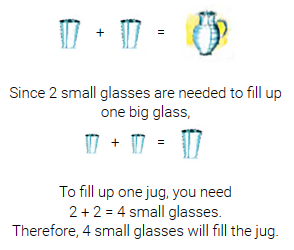
How many small glasses will fill half the jug?
We know tha 2 big glasses fill one full jug. So, one big glass will fill half of the jug.

Nazim found that two big glasses fill the jug.
Shabnam wants to buy one jug full of lemon drink.
How much does she need to pay?
It is given that 2 big glasses fill the jug, and the cost of 1 big glass is Rs. 10.
10 + 10 = 20
Therefore, she needs to pay Rs. 20 for one jug of lemon drink.

Aneesh got a jug. Do you think it is easier to pour into a glass from a jug than a bucket?
Since the bucket is heavier than the jug, it is easy to pour into the glass from the jug.
Fun in Filling Vessels
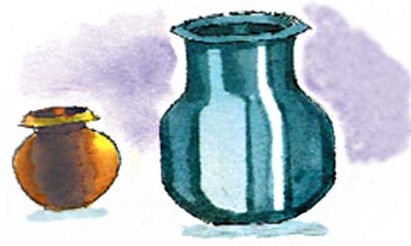
Since the second vessel is bigger than the first one, it will hold more water. Draw a ring around the second vessel. The correct answer is:
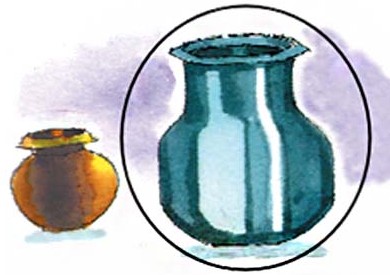
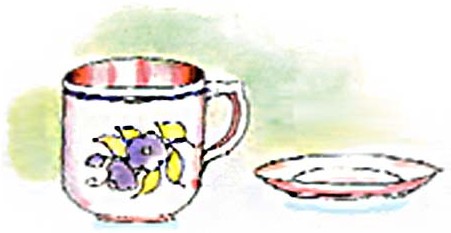
Since the cup is bigger than the saucer, it will hold more water. Draw a ring around the cup. The correct answer is:
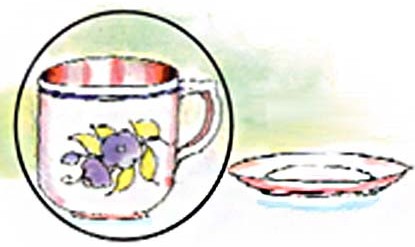
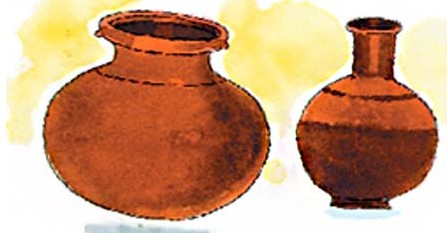
Both vessels given in the picture are of same heights. But the first vessel is broader than the second one. So, the first vessel can hold more water. Draw a ring around the first vessel. The correct answer is:
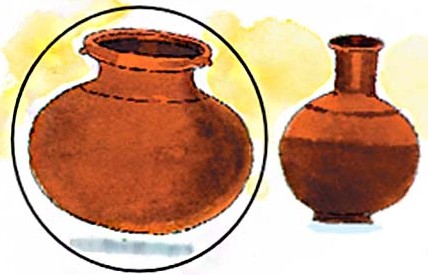
Find out how many cups of water will fill your bottle. First guess and then try it out.
Do it by yourself at your home. Take a cup and fill your bottle with it and count how many cups of water fills the bottle. Answers may vary depending upon the size of the cup and the bottle.
Now, fill a different bottle with the same cup. Which bottle holds less water?
Do it by yourself. Answers will vary according to the sizes of the bottles. A small bottle will hold less water.
Try it with another bottle.
Which bottle holds the least water?
Do it by yourself. The smallest bottle will hold the least amount of water.
Sunaina and Jaspreet brought different vessels from the kitchen. They had a jug, a glass, a mug, a pot and a bowl. They filled each of these with a cup.
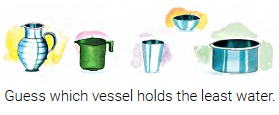
The smallest vessel will hold the least amount of water. The bowl is the smallest vessel among all the given vessels. So, the bowl will hold the least amount of water.
Which vessel holds the most water?
The biggest vessel will hold the most amount of water. The pot is the biggest vessel among all the given vessels. So, the pot will hold the most water.
Now, you collect different vessels from your kitchen. Use the same  cup to fill each of them. Count the number of cups of water each of them can hold. First guess and then do it.
cup to fill each of them. Count the number of cups of water each of them can hold. First guess and then do it.
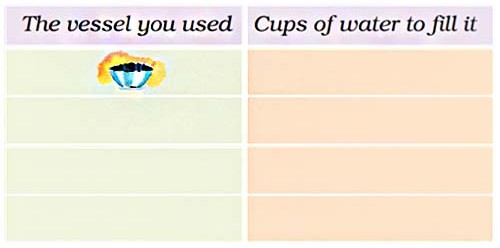
Do it by yourself. Observe the size of each vessel and the number of cups of water required to fill it. The smallest vessel will need the least amount of water and the biggest vessel will need the most amount of water. Answers may vary according to the sizes of vessels. A sample answer is:
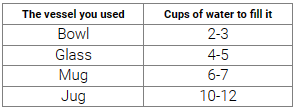
Ring the one which holds more water.
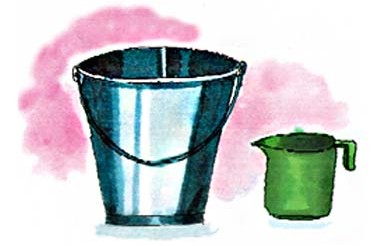
Since the bucket is bigger than the mug, it will hold more water. Draw a ring around the bucket. The correct answer is:
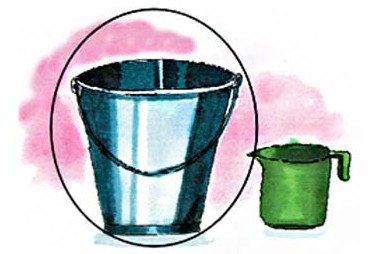
Rani and the Milkman
Oh! Today Anil has given me less milk. Do you think Anil has given Rani less milk? Help her.
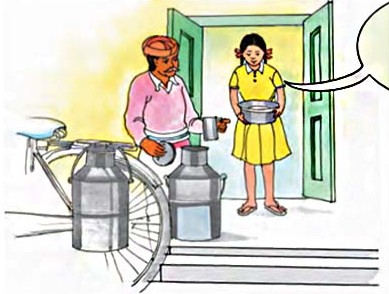
Do it by yourself. The milkman has not given her less milk. Rani’s mother gave her a different pot to take the milk today. Since the pot did not fill up completely it suggests that this pot is bigger than the previous pot.
How much milk does your mother buy every day
Ask your mother and find out the answer to this question.
Try yourself
Take five different types of big vessels from your kitchen. Fill all of them one by one with one jug full of water. What do you see? Why? Talk to your friends about it.
Do as directed. Observe the level of water each vessel can hold. Some vessels will fully fill up with the water and some will not.
Compare the size and shape of each vessel you have taken.
Discuss with your friends why these different vessels hold different levels of water.
Discuss with your teacher the capacities each vessel and how the capacity depends upon the shape and size of the vessel.
Do You Want to Be Like Chirpy?
Repeat it with stones. What happens now? Why?
Do it by yourself. After putting the same number of stones in the second glass, you will see that water will flow out of the glass.
This happens because the sizes of the marbles and stones are bigger than the size of seeds.
Now put the same number of marbles in the second glass. What happens?
Do it by yourself. After putting the same number of marbles in the second glass, you will see that the water will flow out of the glass.
Count the number of seeds used.
Do it by yourself.
Do you want to know how the water in the pitcher came up?
Let’s find out the answer to this question by doing the following activity.
Take two glasses of the same size.
Fill half of each glass with water.
You have to put tamarind (imli) seeds in the first glass to raise the water to the top. Guess how many seeds you will need to put in.
Now, do it.
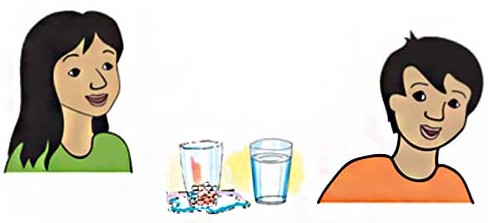
Water is Useful
Find out how much water (in mugs or buckets) is used in your house for each of the following.
I can drink 9 buckets of water at once. How many buckets can two camels drink at once?
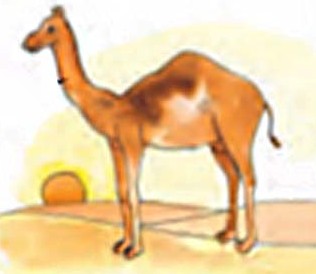
One camel can drink 9 buckets of water at once. Add 9 two times to find out the number of buckets of water 2 camels can drink.
9 + 9 = 18
So, two camels can drink 18 buckets of water at once.
a) How many mugs of water fill one bucket?
b) How many buckets of water do you use to take a bath?
c) How many mugs of water do you use to take a bath?
d) How much water will fill a balloon?
e) How much water is needed to fill a water gun (pichkari)?
Do it by yourself. Find out the answers to these questions by yourself and discuss them with your friends and teacher.

Do it by yourself. Count how much water (in mugs) you use for drinking. Guess and then find out:
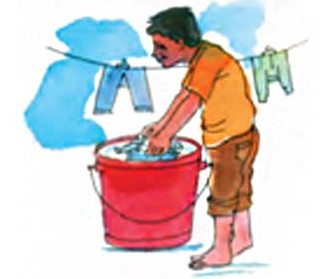
Do it by yourself. Answers may vary. Count how much water (in buckets) is used for washing clothes in your house.
Do it by yourself. Answers may vary. Count how much water (in buckets) you use for taking a bath.

Do it by yourself. Answers may vary. Count how much water (in buckets) you use for taking a bath.
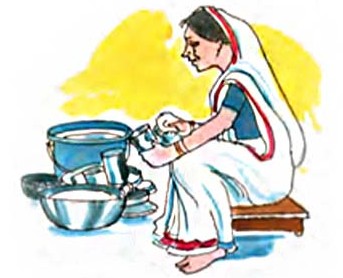
Do it by yourself. Answers may vary. Count how much water (in buckets) is used for cleaning vessels in your house.
Frequently Asked Questions
The NCERT solution for Class 2 Chapters 7 : Jugs and Mugs is important as it provides a structured approach to learning, ensuring that students develop a strong understanding of foundational concepts early in their academic journey. By mastering these basics, students can build confidence and readiness for tackling more difficult concepts in their further education.
Yes, the NCERT solution for Class 2 Chapters 7 : Jugs and Mugs is quite useful for students in preparing for their exams. The solutions are simple, clear, and concise allowing students to understand them better. Additionally, they can solve the practice questions and exercises that allow them to get exam-ready in no time.
You can get all the NCERT solutions for Class 2 Maths Chapter 7 from the official website of the Orchids International School. These solutions are tailored by subject matter experts and are very easy to understand.
Yes, students must practice all the questions provided in the NCERT solution for Class 2 Maths Chapters 7 : Jugs and Mugs as it will help them gain a comprehensive understanding of the concept, identify their weak areas, and strengthen their preparation.
Students can utilize the NCERT solution for Class 2 Maths chapter 7 effectively by practicing the solutions regularly. Solve the exercises and practice questions given in the solution. Also, you can make additional notes and jot down the important concepts for your understanding
Copyright @2024 | K12 Techno Services ®
ORCHIDS - The International School | Terms | Privacy Policy | Cancellation

